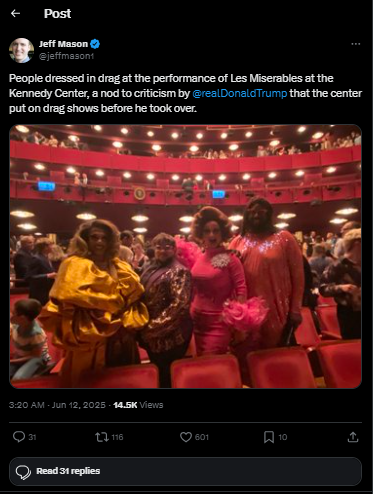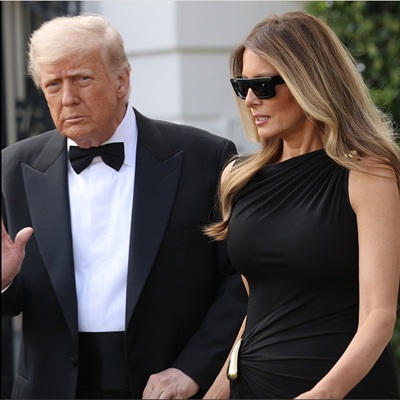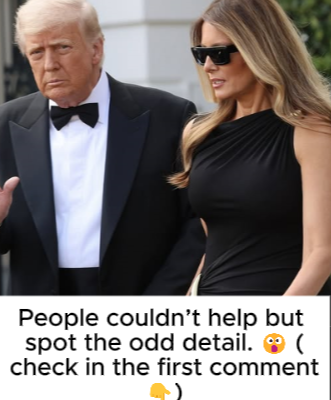On June 11, President Donald Trump and First Lady Melania Trump attended a performance of Les Misérables at the John F. Kennedy Center for the Performing Arts in Washington, D.C. This marked the president’s first return to the iconic venue since overseeing significant changes to its leadership structure and programming priorities. The Kennedy Center, known for hosting a wide range of high-profile cultural events, had become a flashpoint for debates over what kinds of art and performances were deemed acceptable under the new direction. Trump’s appearance was therefore about more than just attending a musical; it symbolized the intersection of politics, culture, and public opinion at one of the nation’s most prestigious stages.
Inside the theater, the reception for the Trumps was polarized, reflecting both the contentious nature of the administration and the themes of the musical itself. As the presidential box came into view, a mixture of applause, boos, and chants echoed through the hall. Some audience members shouted in support, while others voiced pointed opposition, creating a charged atmosphere that alternated between celebration and confrontation. Amid the reactions, the president appeared unfazed and later commented, “I’ve seen it many times, it’s one of my favorites,” referring to Les Misérables. His statement suggested a personal connection to the musical, but the public’s reception underscored the tension inherent in attending politically symbolic events.
During intermission, the atmosphere grew more intense. Audience reactions varied widely: chants of “U.S.A.” from supporters were met with waves of boos from detractors. The president responded to the cheering faction with his characteristic three-pump fist gesture, an expression familiar to his base and frequently interpreted as a sign of triumph or encouragement. News outlets covering the event described the night as a mix of admiration and protest, noting that the crowd’s split reception mirrored the broader polarization in American society. For some, the musical and its political undertones amplified the stakes of the president’s presence. For others, it was a chance to celebrate a cultural milestone.

The lead-up to the performance had also been fraught with controversy. Reports emerged that several members of the Les Misérables cast chose to abstain from performing or attending the event. The theater reportedly offered these actors the option to sit out the evening without penalty, citing personal concerns or objections to the presidential attendance. Additionally, the presence of drag performers in seats donated by critical ticket-holders drew attention. Some viewed it as a deliberate cultural counterpoint to Trump’s earlier pledges to remove what he called “woke” programming from the Kennedy Center’s offerings. In public statements, the president had previously said, “NO MORE DRAG SHOWS, OR OTHER ANTI-AMERICAN PROPAGANDA,” signaling his intent to reshape the venue’s cultural landscape according to his administration’s priorities.
The juxtaposition between the content of Les Misérables and current political events did not go unnoticed. The musical, centered on themes of revolution, social injustice, and the rise of the oppressed against authoritarian power, coincided with federal action earlier that week in Los Angeles, where authorities had intervened in local protests. Media commentators, cultural critics, and politicians quickly pointed out the irony: a story about barricades, uprisings, and collective resistance played out in a theater while government forces were deployed to quash civil unrest. This dynamic made the evening an inadvertent commentary on the relationship between art and real-world power structures.

Beyond the political optics, the president’s attendance was also tied to fundraising efforts. Trump highlighted that the evening had raised more than $10 million, positioning the appearance as both a political and financial success. Earlier in the year, the administration had implemented a conservative overhaul of the Kennedy Center’s board and leadership team. Critics warned that these changes had the potential to chill subscriptions and bookings, though Kennedy Center officials countered that any fluctuations were part of a planned renewal campaign timeline. “We’re going to make it incredible… We raised a lot tonight,” Trump stated confidently, emphasizing his role in shaping the institution’s future and asserting that the Center’s long-term trajectory would remain strong under his influence.
Even outside policy and programming debates, the event became a focal point for viral moments on social media. One image, in particular, captured the attention of viewers: as the couple left the theater, Trump appeared to clasp only the First Lady’s thumb in a handshake-like gesture. Social media quickly amplified the moment, with users interpreting the gesture through the lens of past viral body-language analyses of the couple. While this micro-moment did not change the substance of the evening, it highlighted a recurring phenomenon: nearly every public appearance by the Trumps generates additional cultural commentary, often independent of the event itself.
In the end, the evening at the Kennedy Center became more than a theatrical outing; it was a live demonstration of cultural polarization and media spectacle. Supporters framed it as a reclaiming of a marquee cultural venue and an impressive fundraising achievement, while critics saw a dissonance between the musical’s narrative of rebellion and contemporary government actions. The night functioned, in many ways, as a real-time cultural Rorschach test: it allowed individuals to project their own interpretations, fears, and hopes onto the intersection of art and politics. Les Misérables served as a mirror, reflecting both societal tensions and the enduring power of theater to provoke dialogue far beyond the stage.
Ultimately, Trump’s attendance reminded the public that in today’s climate, even a single night at the theater can reverberate across political, cultural, and social spheres. From applause to boos, from fundraising milestones to viral hand gestures, the Kennedy Center event captured the essence of the modern American spectacle: layered, contentious, and impossible to ignore.
On June 11, President Donald Trump and First Lady Melania Trump attended a performance of Les Misérables at the John F. Kennedy Center for the Performing Arts in Washington, D.C. This marked the president’s first return to the iconic venue since overseeing significant changes to its leadership structure and programming priorities. The Kennedy Center, known for hosting a wide range of high-profile cultural events, had become a flashpoint for debates over what kinds of art and performances were deemed acceptable under the new direction. Trump’s appearance was therefore about more than just attending a musical; it symbolized the intersection of politics, culture, and public opinion at one of the nation’s most prestigious stages.
Inside the theater, the reception for the Trumps was polarized, reflecting both the contentious nature of the administration and the themes of the musical itself. As the presidential box came into view, a mixture of applause, boos, and chants echoed through the hall. Some audience members shouted in support, while others voiced pointed opposition, creating a charged atmosphere that alternated between celebration and confrontation. Amid the reactions, the president appeared unfazed and later commented, “I’ve seen it many times, it’s one of my favorites,” referring to Les Misérables. His statement suggested a personal connection to the musical, but the public’s reception underscored the tension inherent in attending politically symbolic events.
During intermission, the atmosphere grew more intense. Audience reactions varied widely: chants of “U.S.A.” from supporters were met with waves of boos from detractors. The president responded to the cheering faction with his characteristic three-pump fist gesture, an expression familiar to his base and frequently interpreted as a sign of triumph or encouragement. News outlets covering the event described the night as a mix of admiration and protest, noting that the crowd’s split reception mirrored the broader polarization in American society. For some, the musical and its political undertones amplified the stakes of the president’s presence. For others, it was a chance to celebrate a cultural milestone.

The lead-up to the performance had also been fraught with controversy. Reports emerged that several members of the Les Misérables cast chose to abstain from performing or attending the event. The theater reportedly offered these actors the option to sit out the evening without penalty, citing personal concerns or objections to the presidential attendance. Additionally, the presence of drag performers in seats donated by critical ticket-holders drew attention. Some viewed it as a deliberate cultural counterpoint to Trump’s earlier pledges to remove what he called “woke” programming from the Kennedy Center’s offerings. In public statements, the president had previously said, “NO MORE DRAG SHOWS, OR OTHER ANTI-AMERICAN PROPAGANDA,” signaling his intent to reshape the venue’s cultural landscape according to his administration’s priorities.
The juxtaposition between the content of Les Misérables and current political events did not go unnoticed. The musical, centered on themes of revolution, social injustice, and the rise of the oppressed against authoritarian power, coincided with federal action earlier that week in Los Angeles, where authorities had intervened in local protests. Media commentators, cultural critics, and politicians quickly pointed out the irony: a story about barricades, uprisings, and collective resistance played out in a theater while government forces were deployed to quash civil unrest. This dynamic made the evening an inadvertent commentary on the relationship between art and real-world power structures.

Beyond the political optics, the president’s attendance was also tied to fundraising efforts. Trump highlighted that the evening had raised more than $10 million, positioning the appearance as both a political and financial success. Earlier in the year, the administration had implemented a conservative overhaul of the Kennedy Center’s board and leadership team. Critics warned that these changes had the potential to chill subscriptions and bookings, though Kennedy Center officials countered that any fluctuations were part of a planned renewal campaign timeline. “We’re going to make it incredible… We raised a lot tonight,” Trump stated confidently, emphasizing his role in shaping the institution’s future and asserting that the Center’s long-term trajectory would remain strong under his influence.
Even outside policy and programming debates, the event became a focal point for viral moments on social media. One image, in particular, captured the attention of viewers: as the couple left the theater, Trump appeared to clasp only the First Lady’s thumb in a handshake-like gesture. Social media quickly amplified the moment, with users interpreting the gesture through the lens of past viral body-language analyses of the couple. While this micro-moment did not change the substance of the evening, it highlighted a recurring phenomenon: nearly every public appearance by the Trumps generates additional cultural commentary, often independent of the event itself.
In the end, the evening at the Kennedy Center became more than a theatrical outing; it was a live demonstration of cultural polarization and media spectacle. Supporters framed it as a reclaiming of a marquee cultural venue and an impressive fundraising achievement, while critics saw a dissonance between the musical’s narrative of rebellion and contemporary government actions. The night functioned, in many ways, as a real-time cultural Rorschach test: it allowed individuals to project their own interpretations, fears, and hopes onto the intersection of art and politics. Les Misérables served as a mirror, reflecting both societal tensions and the enduring power of theater to provoke dialogue far beyond the stage.
Ultimately, Trump’s attendance reminded the public that in today’s climate, even a single night at the theater can reverberate across political, cultural, and social spheres. From applause to boos, from fundraising milestones to viral hand gestures, the Kennedy Center event captured the essence of the modern American spectacle: layered, contentious, and impossible to ignore.

